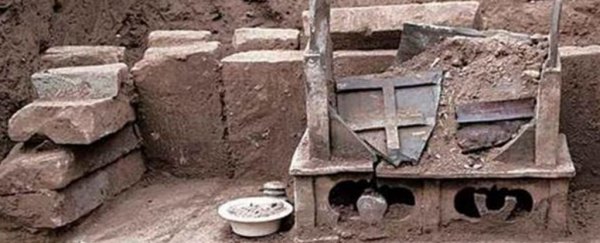1,000 years ago, a pair of monks from Mañjuśrī Temple of the Longxing Monastery in China's Jingzhou Prefecture reportedly spent two decades collecting bits of cremated bone from far and wide which they believed to be the remains of the man known as the Buddha.
And now, their collection has been found.
Whether the materials truly belong to the famous ancient philosopher is a mystery, and will probably stay that way. But in addition to the ossuary, archaeologists also found 260 statues – a discovery that's of cultural and historical significance regardless of the origins of the bones themselves.
The discovery was made by villagers repairing roads about five years ago, and reported in Chinese journals. The reports were recently translated into English in the journal Chinese Cultural Relics.
Archaeologists report the inscription on the box says:
"The monks Yunjiang and Zhiming of the Lotus School, who belonged to the Mañjuśrī Temple of the Longxing Monastery in Jingzhou Prefecture, gathered more than 2,000 pieces of śarīra, as well as the Buddha's teeth and bones, and buried them in the Mañjuśrī Hall of this temple."
śarīra is a broad term describing any kind of relic claimed to be related to the Buddha – the famous "Enlightened One" who was born in what today is Nepal and travelled through the eastern parts of India sometime between the 6th and 4th centuries BCE.
The story goes that on his death, the cremated remains of the man called Siddhartha Gautama – aka the Buddha – were divided up among royal families and disciples, and so were distributed far and wide.
Whoever Yunjiang and Zhiming were, they seemed to have been busy collecting 2,000 bits of burned tooth and bone and putting them into a box over the course of two decades.
Not unlike saintly fingerbones or true pieces of Christ's cross, Buddha's śarīra can have greater cultural significance than biological, with pearl-like pieces of bone revered in Buddhist shrines and temples across the world.
The archaeologists don't speculate on the actual origins of the bones, and aren't certain if the 2 metre (6.6 foot) high statues were buried at the same time as the box.
Crafted between the Wei dynasty (386 to 534 CE) and the Song dynasty (960 to 1279 CE), the stone blocks included a mix of depictions of Buddha himself, seekers of enlightenment, enlightened devotees, gods, and simple inscribed objects called steles.
Historically the inscriptions and assortment of statues provide insights into the history of the culture surrounding the religion.
For many Buddhists, whatever the true nature of the bones, the discovery of this incredible collection from a millennium ago could have immense spiritual significance.
